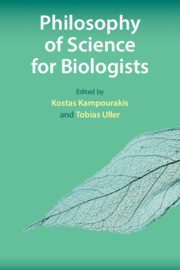Book contents
- Philosophy of Science for Biologists
- Philosophy of Science for Biologists
- Copyright page
- Contents
- Contributors
- Preface
- 1 Why Should Biologists Care about the Philosophy of Science?
- 2 What Constitutes an Explanation in Biology?
- 3 What Is Biological Knowledge?
- 4 What Is the Nature of Theories and Models in Biology?
- 5 How Are Biology Concepts Used and Transformed?
- 6 Why Does It Matter That Many Biology Concepts Are Metaphors?
- 7 How Do Concepts Contribute to Scientific Advancement?
- 8 How Can Conceptual Analysis Contribute to Scientific Practice?
- 9 What Methods Do Life Scientists Use?
- 10 Is It Possible to Scientifically Reconstruct the History of Life on Earth?
- 11 What Is the Basis of Biological Classification?
- 12 What Is the Nature of Scientific Controversies in the Biological Sciences?
- 13 What Is the Relation between Facts and Values in Biological Science?
- 14 A Philosopher in the Age of Creationism
- 15 How Can We Teach Philosophy of Science to Biologists?
- Further Reading
- Index
- References
13 - What Is the Relation between Facts and Values in Biological Science?
Biology in Society
Published online by Cambridge University Press: 04 September 2020
- Philosophy of Science for Biologists
- Philosophy of Science for Biologists
- Copyright page
- Contents
- Contributors
- Preface
- 1 Why Should Biologists Care about the Philosophy of Science?
- 2 What Constitutes an Explanation in Biology?
- 3 What Is Biological Knowledge?
- 4 What Is the Nature of Theories and Models in Biology?
- 5 How Are Biology Concepts Used and Transformed?
- 6 Why Does It Matter That Many Biology Concepts Are Metaphors?
- 7 How Do Concepts Contribute to Scientific Advancement?
- 8 How Can Conceptual Analysis Contribute to Scientific Practice?
- 9 What Methods Do Life Scientists Use?
- 10 Is It Possible to Scientifically Reconstruct the History of Life on Earth?
- 11 What Is the Basis of Biological Classification?
- 12 What Is the Nature of Scientific Controversies in the Biological Sciences?
- 13 What Is the Relation between Facts and Values in Biological Science?
- 14 A Philosopher in the Age of Creationism
- 15 How Can We Teach Philosophy of Science to Biologists?
- Further Reading
- Index
- References
Summary
It is well-known that the dividing line between facts and values can be blurry. This is the case for several reasons. One is that every statement about the world is expressed in human language, which always reflects values and judgments in human societies. Even if we use, for example, the seemingly neutral and factual word, “table,” we cannot fully understand the meaning of the word without knowing what people normally do with tables: eating or working on it, and not putting one’s dirty feet on it. Another reason that facts and values are not mutually exclusive is that statements about what happens in the world necessarily reflect how the world is organized and valued by those inhabiting it. For example, we could say that Mara is a reliable person. We could prove this “fact” by showing a record of all our interactions with Mara since we first met her to prove that she kept her promises and never let us down. At the same time, our statement that Mara is reliable is also a value statement in that it reflects societal (and possibly also personal) values in terms of what kinds of behavior are, or should be, expected from a person in our societies. Keeping a promise is valued by people because it is seen as contributing to the functioning of human interaction and social and political institutions.
- Type
- Chapter
- Information
- Philosophy of Science for Biologists , pp. 255 - 274Publisher: Cambridge University PressPrint publication year: 2020
References
- 1
- Cited by



